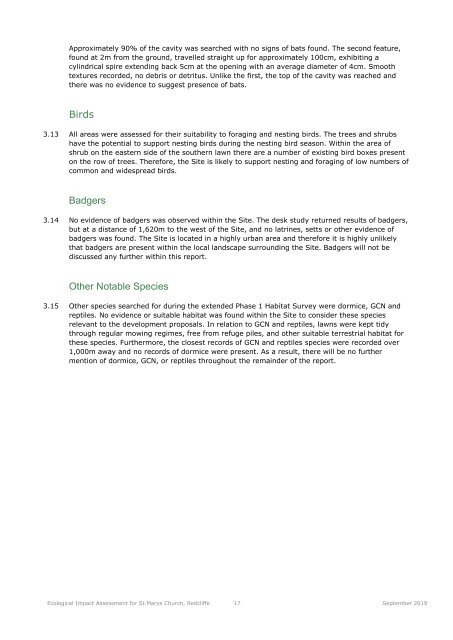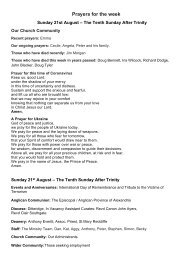St Mary Redcliffe Ecological Impact Assessment
You also want an ePaper? Increase the reach of your titles
YUMPU automatically turns print PDFs into web optimized ePapers that Google loves.
Approximately 90% of the cavity was searched with no signs of bats found. The second feature,<br />
found at 2m from the ground, travelled straight up for approximately 100cm, exhibiting a<br />
cylindrical spire extending back 5cm at the opening with an average diameter of 4cm. Smooth<br />
textures recorded, no debris or detritus. Unlike the first, the top of the cavity was reached and<br />
there was no evidence to suggest presence of bats.<br />
Birds<br />
3.13 All areas were assessed for their suitability to foraging and nesting birds. The trees and shrubs<br />
have the potential to support nesting birds during the nesting bird season. Within the area of<br />
shrub on the eastern side of the southern lawn there are a number of existing bird boxes present<br />
on the row of trees. Therefore, the Site is likely to support nesting and foraging of low numbers of<br />
common and widespread birds.<br />
Badgers<br />
3.14 No evidence of badgers was observed within the Site. The desk study returned results of badgers,<br />
but at a distance of 1,620m to the west of the Site, and no latrines, setts or other evidence of<br />
badgers was found. The Site is located in a highly urban area and therefore it is highly unlikely<br />
that badgers are present within the local landscape surrounding the Site. Badgers will not be<br />
discussed any further within this report.<br />
Other Notable Species<br />
3.15 Other species searched for during the extended Phase 1 Habitat Survey were dormice, GCN and<br />
reptiles. No evidence or suitable habitat was found within the Site to consider these species<br />
relevant to the development proposals. In relation to GCN and reptiles, lawns were kept tidy<br />
through regular mowing regimes, free from refuge piles, and other suitable terrestrial habitat for<br />
these species. Furthermore, the closest records of GCN and reptiles species were recorded over<br />
1,000m away and no records of dormice were present. As a result, there will be no further<br />
mention of dormice, GCN, or reptiles throughout the remainder of the report.<br />
<strong>Ecological</strong> <strong>Impact</strong> <strong>Assessment</strong> for <strong>St</strong>.<strong>Mary</strong>s Church, <strong>Redcliffe</strong> 17 September 2019


















